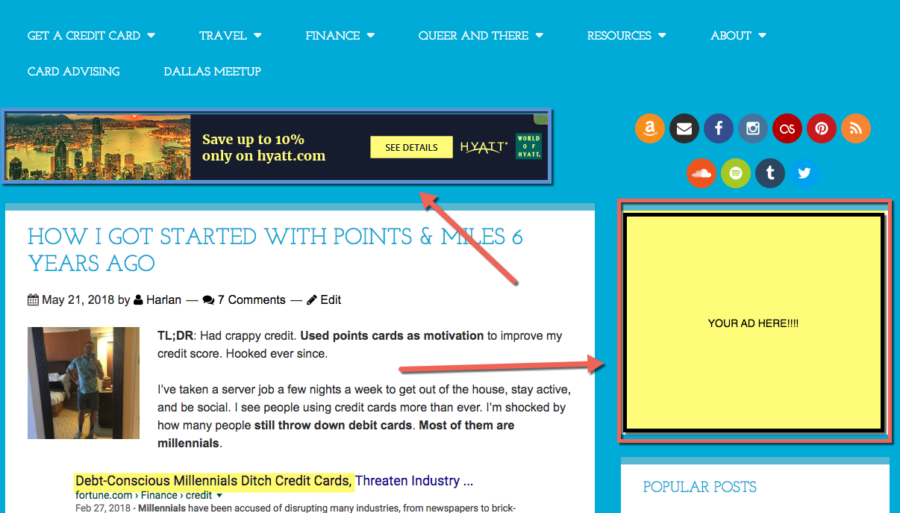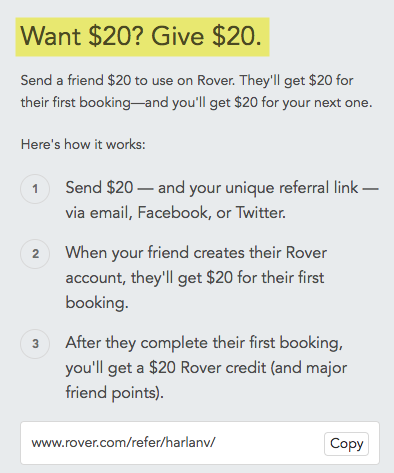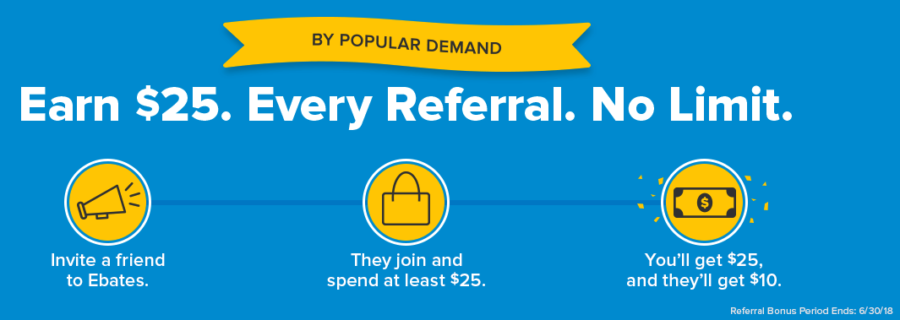When I started my blog in March 2013, I knew nothing about SEO or link-building, and certainly nothing about monetization. I knew about Google Adsense – and that’s it.
Over the years, my writing got stronger. My audience grew. And along the way, I started monetizing. These days, I earn ~$1,000 every month from my blog. That’s $12,000 a year – which could go a long way toward savings, paying down debt, or splurging on a fun trip.
The 3 best ways to monetize your content are:
- Ad placements
- Referral links
- Affiliate links
To be clear, these methods assume you already have website traffic and an audience. But if you’re still growing your site, you can start incorporating monetization right away. And if you already have decent traffic, you’re missing out on fairly passive income!
Another note: $1,000 a month definitely is NOT the ceiling. Like everything, you get what you put into it. Some bloggers are making six figures a year. Some crack $100 a month.
Whatever you do, make sure to incorporate links for products you believe in and things you really care about.
Reader trust is your #1 currency. It’s hard to earn and easy to lose. The second you lose a reader’s trust, you may never get it back. And you can lose it in a split second. Readers can smell when you’re not authentic. So do NOT prioritize monetization over strong, balanced content. If you lose your readers, there will be no traffic. Always put your readers first.
How to monetize a blog
The 3 main ways I’ve found effective are ad placements, referral links, and affiliate links.
Ad placements are just that – ads you place in corners of your website.
Referral links are those you find for referring services or products on company websites. They’re usually auto-generated. Think referring things like Uber rides, pet insurance, or bulk shopping. Sometimes these links earn you cash; sometimes they get you credits toward future spending.
Finally affiliate links are links you have to apply for. That includes Amazon, commission services, and credit card links. These are always cash payments.
My site’s income is split nearly even between the 3. I get 1/3 of income from ads, another 1/3 from referral links, and the last 1/3 from affiliate links. Your site might skew in other directions. Or you might decide you don’t want ads, but you do want affiliate links. Always do what you’re comfortable with.
And always put your content first, then monetize later. Your content is your foundation.
Let’s go into more detail. And talk about specific services!
1. Ad placements
Yeah, you could do Google Adsense. It’s easy to implement and pretty much everyone is approved. It’s a great place to start.
If your blog gets considerable traffic (say, over 50,000 views per month – or when you hit that mark), you can apply to other ad networks with much higher payouts.
I recommend AdThrive or Mediavine. Their payouts are much higher than Adsense and the service is more tailored. Some bloggers I know earn 3X to 4X more with these networks when compared to Adsense.
There’s also Media.net. They have the little ads that are strips of keywords. These are great to insert at the bottom of posts. The payouts aren’t much, but they ads aren’t very big either.
Your audience expects your site to have ads. We’ve “trained” our eyes to deduce ads from content. So an ad here or there isn’t going to detract as long as it’s not too big or flashy.
Do it right
One or two ads at the top is totally fine. You can place a couple more after a couple of full scrolls down your page. This is key.
Do NOT bombard your audience with a page full of ads. The focus should be on your content: your headline, your headings, your photos, and your words. You’ve been to a page with tons of ads. Don’t do that.
If your ad service recommends tons of big, splashy ads with scrolling photos, videos, and god forbid auto-loading ads WITH SOUND, scale them back.
If ads distract you from your own content, they’re definitely distracting for your visitors. So have a couple, but don’t go crazy.
The best spots to put ads are:
- Right at the top (in your “leaderboard” position) – this one is usually wide and narrow
- In the top corner – usually a square
- At the bottom of your post – usually another wide, thin strip
If you opt for more, place them strategically. Also, experiment! Compare what works month-to-month with different placements and services. When you hit a good stride, let it ride.
2. Referral links
I love referring cool services to my readers. That’s because I personally use them, know what to expect, and recommend them to friends.
If your content is say, personal finance, and all of a sudden you’re recommending a kitchen item, that’s fine. Know why? Because you’re living a full life and writing about it. As long as you relate the content back to your site’s core values in some way with things you truly care about, go for it.
For example, instant pots are all the rage right now. This could relate to personal finance because you save money cooking several meals at once. Or you waste less food because you can throw anything in there. Or maybe it’s a cheap way to have friends over so you don’t spend on an expensive night out.
All of these topics could work from a personal finance angle.
I personally love saving money, getting a good deal, and traveling. I also have an article about coconut oil. 🤯
The angle was how to use it during travel to replace other toiletries and combat dehydrating recycled air on planes. The point is, as long as you believe in what you’re recommending and can relate it back to your core topics, that’s OK.
Don’t start recommending everything you find for the sake of writing an article about it. Be judicious and genuine and that’s all you need – this applies to everything on your blog!
Earn cash or credits
You won’t always get cash in hand from referral links. Sometimes, you’ll get a credit toward the service you recommend.
For example, Rover is offering $20 when a friend books dog boarding services. Because I use Rover when I travel, this saves me money directly – in the form of a discount. So it’s not exactly “income” but it’s money I actually save. Plus, I’ve used the service several times without issue and can recommend them based on personal experience.
Other times, referral links offer cash for referring.
At the time of writing, Ebates will award you $25 in cash for every new user you refer who spends at least $25 after clicking through their site. There’s no limit to how many people you can recommend. So if you refer 1,000 new users, you could get $25,000. Or you could get a smooth $100 for referring 4 new sign-ups.
They’ll send you a check for the full amount after conditions are met. That’s pretty sweet for recommending a service you like!
3. Affiliate links
Affiliate links are different from referral links because you have to apply to get them.
This last monetization method is also the most slippery slope. Lots of peeps get greedy and prioritize payouts over quality content. This is a sure move to lose readers and turn off new ones.
Fact is, people have been fed so much marketing bullshit, so much “spin,” and so many “OMG this is the best deal ever you have to get it rn!!!!!!!!” that they can see through it instantly.
Affiliate links can earn you the most but can also do the most damage. When used correctly, they are an excellent way to supplement your blog income.
Here are my favorite ways to get commissionable links for my blog.
FlexOffers and CJ
- Link: FlexOffers
- Link: CJ
These advertising networks work the same: you apply as a publisher, then apply for each individual program you want to promote. There are many of these networks (Rakuten is another).
Generally, most advertisers are on popular networks. So there’s no need to join them all, unless you want to compare the differences. Again, they’re all pretty much the same. And the payouts are usually similar.
For example, I checked CityPass on FlexOffers and CJ.
They offer a 5% commission at FlexOffers.
And 6% commission through CJ.
On both networks, you’ll find thousands of popular merchants selling everything you can think of. So if you’re writing about gifts for travelers, best baby shower presents, what to wear to an event, or whatever your niche is – you will definitely find ways to monetize on these networks.
Skimlinks
- Link: Skimlinks
This is my ace in the hole. I love love love Skimlinks. They’re an advertising network like the others. The differences are:
- You only have to apply one time
- You do NOT have to pull new links every time – just link directly to the merchant and they’ll convert the link automatically
Skimlinks has access to all the usual merchants – and they also get preferred rates on Amazon.
Even better, you don’t ever have to go in and pull links. The link on your site will read as (for example) https://www.citypass.com when someone hovers over it. But when they click, Skimlinks springs into action via a WordPress plug-in, and converts it automatically to an affiliate link.
So link liberally! New merchants are coming and going all the time. All you have to do is link directly to a product or item and let Skimlinks do the rest. This is by far the easiest and most automatic way to earn extra affiliate income from your blog. If you only join ONE affiliate network, let it be Skimlinks.
It’s also the one that’s earned me the most commissions – usually over $100 a month just for linking to merchants I genuinely like.
Plus, if you already have links in your past content, those instantly become monetized once you add Skimlinks. Content you’ve already written can earn you new income. How cool is that?
Credit card and niche affiliate links
Of course, there are tons more affiliate networks selling everything from credit cards to private jet memberships to premium-grade coconut oil to domain names. You name it, there’s a way to monetize it.
If you poke around my site, you’ll see I promote credit card offers through CardRatings. I specifically applied for this program, which comes with its own set of rules and standards.
Some companies run their own affiliate programs, like Dreamhost for website hosting. There’s no one-stop shop for these – learning about them comes from knowing your industry, looking on company webpages, or asking other bloggers in your niche.
It’s worth it, too – because these links often pay the most. Credit card commissions through affiliate links can be anywhere from $3 to a few hundred. So you can do well if you sell a few of certain cards each month.
This one is also that slippery slope I mentioned earlier. If you only write about high-commission offers, your audience will see through it pretty quickly. However, if you disclose your relationship with the networks, provide even-handed reviews, and guide your readers ethically, many will be happy to click your links.
As long as you do right by your readers, go for it. Ask them to use your links. And consider it a nice bonus when and if they do.
Make it pretty
- Link: Pretty Links
- Link: ThirstyAffiliates
No one wants to see a long affiliate link when they click around your site.
Compare these by hovering over:
- Try ThirstyAffiliates! (long link)
- Try ThirstyAffiliates! (short link from my domain name)
They both point to the same page. The top link is directly from ThirstyAffiliates. As far as affiliate links go, it’s a short one.
But you can further shorten it – and make it point from your domain – with easy WordPress plug-ins.
Both work the same: insert a long domain, add a shorter code, and redirect. The biggest difference is with ThirstyAffiliates, you can set certain keywords to automatically link out.
Say you talk about shopping on Amazon a lot. ThirstyAffiliates lets you take every instance of “Amazon” on your site and link it to your Amazon affiliate page. I personally find it a bit much. But if you use it judiciously in conjunction with Skimlinks, you can link automatically and cleanly to tons of commissionable websites.
I use Pretty Links on my page – it’s easy to track the clicks and add shorter links. Regardless of which you go with, you should definitely add one to your site. Visitors like seeing short, neat links and opposed to long URLs with lots of random code. It’s mostly a comfort/aesthetic thing. But anything that makes your readers feel better about clicking your links is worth it.
Bottom line
I firmly believe every blog can earn extra money. This is accomplished with:
- Ad placements
- Referral links
- Affiliate links
You don’t have to do all 3. And you can play around and see what feels best for your branding and content. Readers don’t mind if you monetize. Most expect it. And some are happy to use your links if they appreciate the value you bring by saving them time or money, or sharing a cool tip or trick.
Making good content is the best way to grow your readership. Earning extra income through monetizing is a nice reward – and that’s how you should think of it. Once you have an established base, there’s no reason not to monetize. It’s literally free money for your existing views and clicks.
Once you find what you like, you can fine-tune placement, look into native advertising, and add new partnerships through sponsorships, guest posts, and special opportunities. And with good content, believe me, those will come.
You can start right away by adding one monetization method to your blog. Then scale up or down when you’re ready.
Any questions? I’ll do my best to help in the comments section.
Happy monetizing! 💸
Earn easy shopping rewards with Capital One Shopping—just log in and click a link.
Announcing Points Hub—Points, miles, and travel rewards community. Join for just $9/month or $99/year.
BEST Current Credit Card Deals
The responses below are not provided or commissioned by the bank advertiser. Responses have not been reviewed, approved or otherwise endorsed by the bank advertiser. It is not the bank advertiser's responsibility to ensure all posts and/or questions are answered.












Leave a Reply